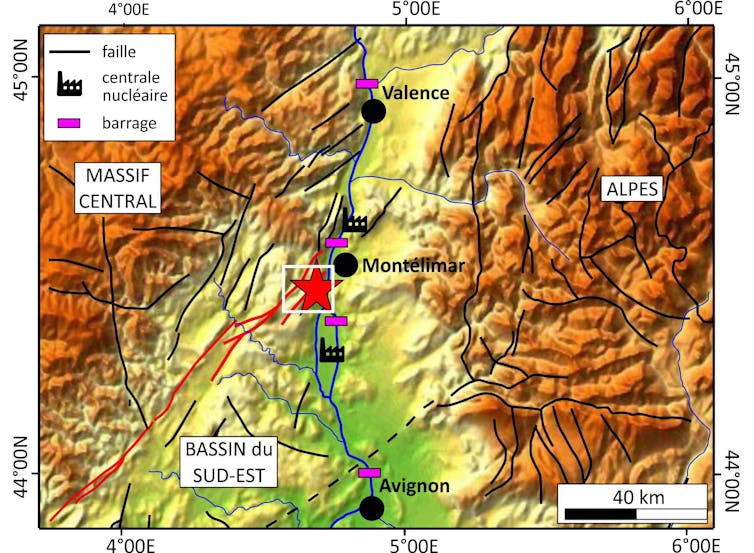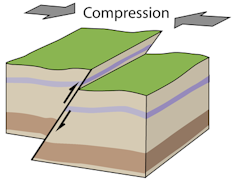What the Le Teil earthquake teaches us about seismic risk in mainland France
One year ago, on November 11, 2019 at 11:52 am, the Montélimar region was strongly shaken by a magnitude 5.4 earthquake.
Christophe Larroque, University of Reims Champagne-Ardenne (URCA)Jean-Francois Ritz, University of MontpellierLaurence Audin, Institute of Research for Development (IRD)Matthieu Ferry, University of Montpellier and Stéphane Baize, Institute for Radiological Protection and Nuclear Safety (IRSN)

With over 700 buildings seriously damaged and four people injured, this earthquake, felt throughout south-eastern France, was the most destructive in mainland France since theArette earthquakein the Pyrenees in 1967. This region, bordering the Rhone valley, is particularly sensitive due to the presence of several conurbations and major industrial facilities: dams, nuclear power plants, roads, railways and waterways.
This earthquake has prompted us to re-evaluate the seismic risk in mainland France: on the one hand, we now need to take into account this type of very shallow earthquake, capable of producing strong ground movements; and on the other, we need to take into account the possibility of surface rupture, i.e. a permanent break in the ground, which presents a particular danger for sensitive installations.
A shallow earthquake with a clear ground shift
A few minutes after the quake, we knew that the epicenter was located near the village of Le Teil, with a very shallow focus (the zone where the rupture is initiated at depth), between one and three kilometers below ground, which explains the high intensity of ground movements and, consequently, the scale of the destruction. In fact, the seismic waves generated at the focus travelled a short distance before reaching the surface, and their energy was only slightly attenuated.

Christophe Larroque, Author provided
That afternoon, the first teams of seismologists set off to install sensors in the field to record aftershocks - the smaller magnitude tremors that systematically follow a major earthquake. The next day, radar images taken by satellite and analyzed by "radar interferometry" revealed vertical shifts in the ground surface exceeding ten centimetres.
For the geologists, two observations stood out: firstly, the focus of the earthquake was very shallow; secondly, the zones of vertical ground displacement seen with radar image processing were aligned almost rectilinearly. These observations are very important, as they suggest that the part of the fault that ruptured during the earthquake (the so-called "coseismic" rupture) reached the surface, which, for an earthquake of this magnitude, is a very rare event. So rare that, at the time of the Le Teil earthquake, no indisputable coseismic rupture at the surface had yet been described in mainland France.
The formation of a "step" on the surface
The vertical shifts detected by radar interferometry are aligned along a north-east/south-west direction corresponding to an older fault, the Rouvière fault. Their analysis indicates the uplift of the compartment to the south. On November 13, a team from several French laboratories set off in search of potential surface ruptures. Despite difficulties in the field, due to vegetation and steep slopes, several indications of ground surface rupture were discovered, some showing vertical offsets of between 2.5 and 15 centimetres.

Philippe Desmazes/AFP
These measurements also show that the southern compartment of the fault has uplifted, and their distribution attests that they are indeed the consequence of the arrival at the surface of the coseismic rupture associated with the earthquake.
An old flaw... but still active
These observations are unprecedented. This is the first time that such a "coseismic" rupture - the rupture of the fault during an earthquake - has been observed on the surface and "live" in France. There are very few documented cases worldwide of earthquakes of magnitude less than 5.5.
The Rouvière fault, on which the Le Teil earthquake occurred, is an ancient fault that was not mapped as active, i.e. likely to produce such an event.

R. Lacassin/Wikipedia, CC BY-SA
Some ten kilometers long, it is one of the northern segments of the great Cévennes fault system, which stretches over 120 km between Lodève and Valence. The last major movements on the Rouvière fault date back to the Oligocene period, between 35 and 25 million years ago. During the Oligocene, this fault functioned as a "normal" fault in an extensional tectonic regime, contemporary with the opening of the western Mediterranean Sea. Movements along the fault caused the Rhône valley to subside in relation to the Ardèche rim.
The movements of the Rouvière fault have been reversed
During the Le Teil earthquake, the southern compartment was uplifted. The 2019 earthquake therefore indicates that movement along the Rouvière fault has reversed.

RobinL/Wikipedia, CC BY-SA
Fault inversion is a well-known process in the evolution of major geological features. In the present case, the Rouvière fault operated in a "normal" direction in the past, i.e. the block to the south of the fault descended relative to the block to the north. Recently, however, the direction of slip has been reversed, with the southern block moving up along the fault plane relative to the northern block.
The Le Teil earthquake is particularly interesting from this point of view too, as it illustrates "live" the inversion of a normal fault, and consequently the change in tectonic regime.
Since the 1960s, it was thought that the region's earthquakes could be explained fairly simply by the convergence of the African and European plates, which generates northward forces from the plate boundary south of the Mediterranean. However, observations and modelling carried out over the past twenty years have called this unambiguous mechanism into question: it appears that local processes such as erosion, the melting of the great Alpine glaciers 15,000 years ago, or the circulation of fluids in the Earth's crust are also processes capable of producing earthquakes.
Human actions on the Earth's surface have also been discussed as potentially responsible for triggering earthquakes. In the case of Le Teil, the extraction of a large mass of rock in a quarry located above the fault could be the cause of the event.
In short, the origin of the forces producing "intraplate" earthquakes in Western Europe is still not clearly understood and is the subject of much research.
Also read:
Aegean Sea earthquake: what do scientists know after a few days' work?
Exploring the past to better understand the present and future
Paleoseismologists decipher past earthquakes. In this case, they study the Rouvière fault and the other faults that make up this part of the Cévennes fault network, to determine whether they had already produced surface ruptures within the last 2 million years. They analyze whether earthquake-related deformations (e.g. cracks, displacement fractures, folds, tilts) affect the most recent sedimentary layers (e.g. slope scree, fluvial alluvium, sands) at the trenches they cut through the faults.

Christophe Larroque, Author provided
They seek to determine the ages and displacements produced by these deformations, in order to estimate the frequency and magnitude of ancient earthquakes. Assuming that the current behavior of a fault is close to its past behavior (the principle of "actualism"), paleoseismological data can be used to discuss the probability of a fault producing an earthquake over a given period of time.
Let's hope that the work currently underway in the Le Teil area will provide sufficient data to enable us to carry out this seismic risk assessment on this part of the Cévennes fault system.![]()
Christophe Larroque, Associate Professor, University of Reims Champagne-Ardenne (URCA)Jean-Francois Ritz, CNRS Research Director, University of MontpellierLaurence Audin, Director of Earth Sciences Research , Institute of Research for Development (IRD)Matthieu Ferry, Senior Lecturer in Geomorphology, University of Montpellier and Stéphane Baize, Researcher in earthquake geology, Institute for Radiological Protection and Nuclear Safety (IRSN)
This article is republished from The Conversation under a Creative Commons license. Read theoriginal article.